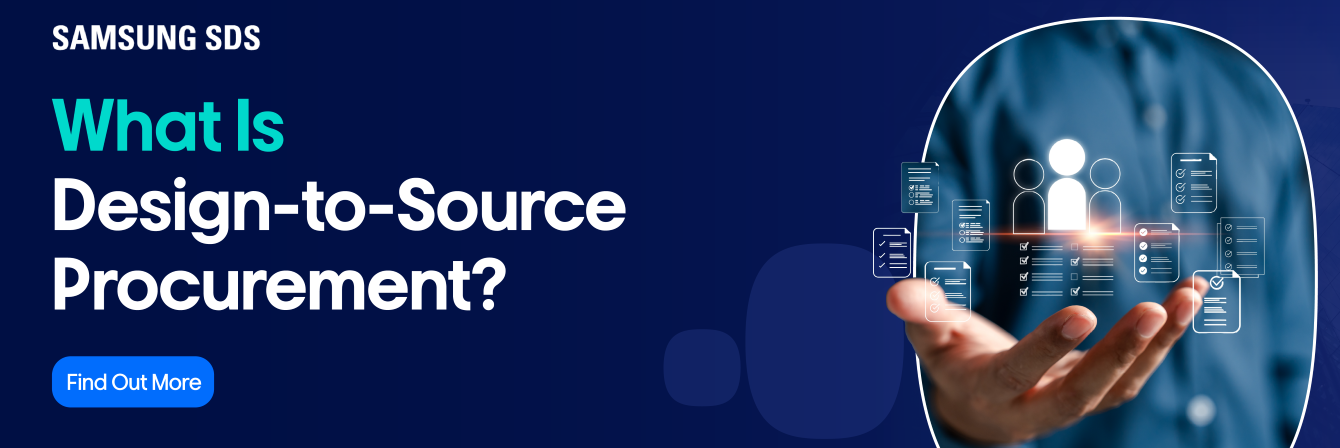
Do you remember when cell phones didn’t have cameras? It feels so natural now that it’s hard to remember how revolutionary the idea was, but one day the two came together and that industry was never the same again.
Something similar is happening in direct procurement right now. You might know about software that digitizes your procurement process, but the software that enhances and extends your procurement process in ways you didn’t know were possible is the software shaping the next evolution of the function.
Design-to-source procurement isn’t just the future; it’s the present for top companies relying on the latest technology to stay ahead.
Defining Design-to-Source Procurement
To put it simply, design-to-source capabilities extend your direct procurement process upstream to bridge the gap between product design and sourcing teams.
This earlier starting point means introducing design thinking into the procurement process while engineers working on new product designs or new product introductions are likewise equipped with sourcing intelligence during their tasks. The goal of design-to-source is to eliminate the silos that come from traditional procurement models, empowering people and processes with information, visibility, and collaboration earlier in the workflow.
At its core, this idea isn’t even a new one. Many companies have long experienced the problems that come along with a transactional handoff, and subsequent back-and-forth, between engineering and sourcing teams. They’ve seen the need and might have even attempted to improve collaboration, but setting up a few extra meetings and sharing spreadsheets only goes so far.
What is new is the availability of tangible, proven design-to-source procurement technology ready to solve your challenges and help you reap all the benefits that come with that territory.
Reaping the Benefits of Design-to-Source Procurement
When you appropriately apply design-to-source principles in your direct procurement processes, you limit elements of risk and inefficiency early in your workflow before they have a chance to multiply. This brings the types of benefits you thought were only aspirational. There are too many to mention in one article, but let’s look at the three that are likely at the top of your list:
Save Time
Connecting design and sourcing teams shortens procurement cycle times and gets your new products and product updates to market faster, which is crucial in an era where your customers expect shorter product lifecycles and regular innovation.
An ever-changing bill of materials (BOM) is a significant efficiency roadblock solved by design-to-source, because when sourcing team members know how engineers are planning a product’s design and can influence that design, they are able to identify critical components and provide cost guidance earlier than ever before. This means the BOM changes less often and less significantly.
It all amounts to less rework, less redesign, and less back-and-forth with endlessly changing parts that extend timelines past target dates.
Save Money
When 80% of a product’s cost is determined during the first 20% of activities, then the importance of starting sourcing activity during product design becomes clear.
Gaining procurement insights earlier in the product development lifecycle means estimating costs faster and more accurately by looking at each stage of development and making informed decisions on direct material spend instead of guesses. Your capabilities for should-cost analysis and part similarity analysis are unlocked, meaning you can adapt to market or geopolitical changes more smoothly while also identifying cost-effective ways to procure common parts across other products in your portfolio.
An improved ability to both estimate costs and manage costs is how companies doing design-to-source procurement right are actively saving millions of dollars every year, not by cutting corners, but by making smarter, faster decisions from day one.
Improve Supplier Relationships
Starting the procurement process during product design doesn’t just help your internal teams collaborate, it helps turn your supplier conversations from transactional to collaborative.
Design-to-source efforts that start sourcing tasks earlier naturally engage suppliers earlier in the process as well. With more lead time and fewer last-second requests, the relationship is set up for a smoother and more efficient experience for everyone. It also builds a foundation of information that unlocks true collaboration. Whether that means discovering alternative components faster, discussing more accurate market pricing, or brainstorming ways to meet updated regulations and sustainability benchmarks, your supplier relationships become assets to your business.
Think of it like the person in your friend group who is always changing plans at the last minute, asking you for favors, and causing you more headaches than smiles. Nobody wants to be that friend.
Asking the Right Design-to-Source Capability Questions
When different departments are not traditionally set up to collaborate at the level required to reach your aggressive business goals, it can be hard to break down the silos. Yes, digitizing your procurement process will help tremendously, but adding a focus on design-to-source isn’t just about digitizing – it’s about your people, processes, and technology working together to make more informed decisions.
Informed decision-making actually starts right now, before you even consider spending any of your budget on a solution that makes big promises. Regardless of what any marketing materials might say, very few solutions offer you full design-to-source capabilities. As you explore and vet different technology options in this arena, ask vendors the questions that cut through the buzzwords and to the core of what the product will do for you:
- How do you define “design-to-source” in direct procurement? Go deeper than surface-level.
- At which point of the product design workflow can sourcing activities begin? How early can your solution help me identify critical components? Can RFI and RFQ activities begin before a prototype is locked?
- How do you enable BOM collaboration and version control? Can you handle thousands of line items? What if I need to share a BOM with internal or external stakeholders?
- In what ways are you applying AI to the process? Do you have your own AI team with its own AI patents? What are your data practices related to AI?
- Do you have cost and quotation analysis support based on current market and supplier data, even when laws, prices, and supply chains are changing rapidly?
- How can you help me conduct an item similarity analysis to uncover efficiencies across my product lines?
It’s up to you, your team, and your stakeholders to ask specific questions like these and many more. As you do your due diligence, dig into conversations around design-to-source functionality but don’t hesitate to walk away when you realize a solution just doesn’t have the capabilities you need to save time, lower costs, and empower your people across departments.
Preparing for the Future of Design-to-Source Procurement
Imagine being a cell phone manufacturer just before the era of camera phones and you have the opportunity to add a camera to your product before the majority of the market. This is your reality in direct procurement. Once the tipping point comes, most procurement processes will formally include design-to-source just as they include source-to-pay or procure-to-pay activities right now.
The design-to-source function is about to blossom across the world. With the right technology, you can future-proof your organization and cement your place ahead of the competition. It’ll be a such a pretty sight, you might even want to stop and take a picture. Anyone have a camera handy?
See what design-to-source procurement looks like in practice and learn how you can lead the charge when you watch this on-demand webinar .
